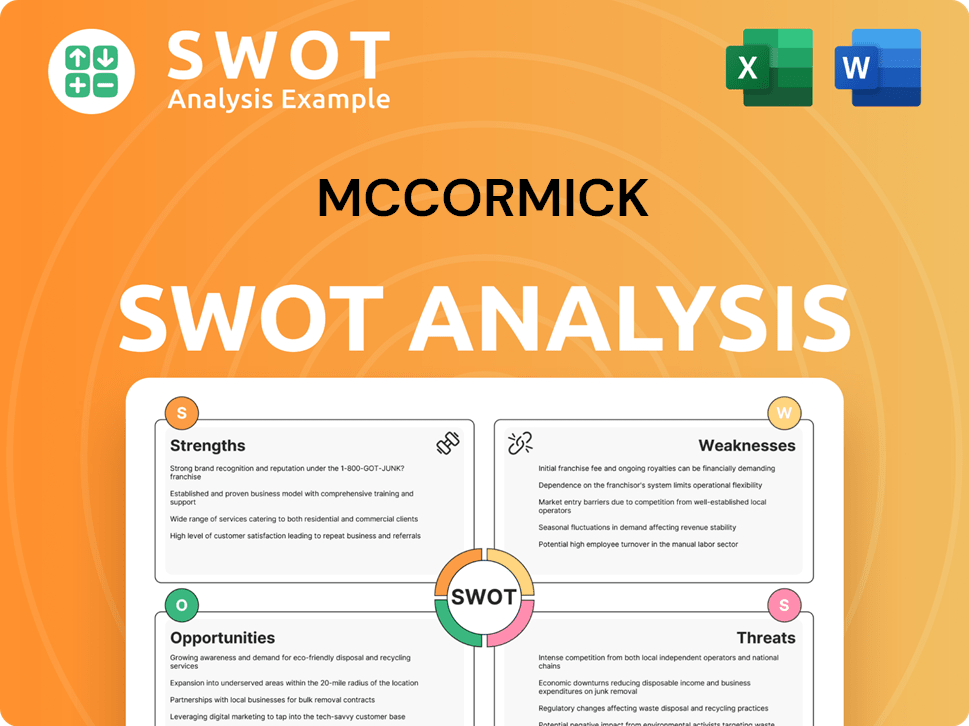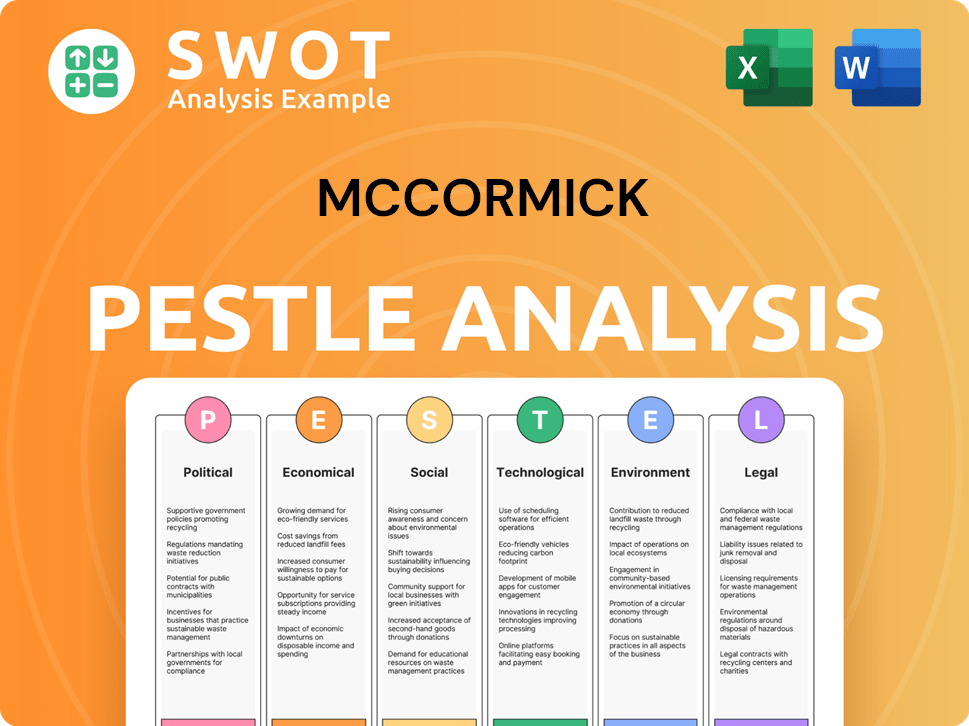McCormick Bundle
How Did a Basement Operation Become a Flavor Empire?
Embark on a flavorful journey through the McCormick SWOT Analysis, a story of innovation and enduring taste. From its humble beginnings in 1889, the McCormick Company, a spice company, transformed itself into a global leader. Explore the fascinating McCormick history, tracing the evolution of McCormick spices from a small operation to a household name.

The McCormick Company's story began in Baltimore, Maryland, a testament to the vision of its Company founder. Understanding the brief history of McCormick & Company reveals how early business practices and a commitment to quality shaped its trajectory. Discover how McCormick's early spice products and strategic expansions solidified its position in the spice industry and beyond, making it a dominant force in the market.
What is the McCormick Founding Story?
The McCormick Company, a prominent name in the spice industry, has a rich McCormick history dating back to the late 19th century. This Spice company's story begins with a vision to provide high-quality flavorings to consumers. The company's founding marks a significant chapter in the evolution of the spice market.
The McCormick Company's journey began on September 21, 1889. The company was established in Baltimore, Maryland, by Company founder Willoughby M. McCormick. Initially, the company operated from a single room in a basement, a testament to its humble beginnings.
The early business model of the McCormick Company focused on direct sales to consumers, offering a selection of extracts and ground spices. The company's commitment to product purity and quality quickly set it apart from competitors. This direct approach helped build strong customer relationships and provided valuable market feedback.
Willoughby M. McCormick started the company in Baltimore, Maryland, on September 21, 1889. He aimed to offer pure, high-quality spices and extracts, a contrast to the adulterated products of the time.
- The company started in a single room in a basement with limited capital.
- The initial product line included extracts like vanilla and lemon, along with ground spices.
- Willoughby McCormick personally delivered products, building direct customer relationships.
- The late 19th-century context, with its focus on domesticity, supported McCormick's venture.
McCormick SWOT Analysis
- Complete SWOT Breakdown
- Fully Customizable
- Editable in Excel & Word
- Professional Formatting
- Investor-Ready Format

What Drove the Early Growth of McCormick?
The early growth of the McCormick Company, a leading spice company, was marked by strategic product and geographical expansion. From its beginnings, the company broadened its offerings beyond extracts to include a wider variety of spices and food colorings. This expansion, coupled with a focus on quality, helped establish the company's reputation and drive early sales.
Following its founding, the McCormick Company quickly diversified its product line. The 'Bee Brand' spices became widely recognized, significantly boosting the company's visibility. This expansion included teas, mustards, and seasoning blends, broadening its appeal and market reach.
Initial distribution focused on the Mid-Atlantic region before expanding nationally. The move to a larger facility in Baltimore, Maryland, in 1903, supported growing operations. Acquisitions, like the F. G. Frank Tea & Spice Company in 1912, expanded product offerings and market presence.
Charles P. McCormick, son of the Company founder Willoughby McCormick, took on a more prominent role, driving expansion. The market consistently responded positively to McCormick's products, due to quality and innovative packaging. By the mid-20th century, McCormick had become a household name.
The company navigated the competitive landscape by focusing on premium products and effective marketing strategies. This approach helped the McCormick spices company maintain its position in the market. The emphasis on quality and innovation distinguished McCormick from its competitors.
McCormick PESTLE Analysis
- Covers All 6 PESTLE Categories
- No Research Needed – Save Hours of Work
- Built by Experts, Trusted by Consultants
- Instant Download, Ready to Use
- 100% Editable, Fully Customizable

What are the key Milestones in McCormick history?
The McCormick Company's history is marked by significant milestones, from its founding in Baltimore, Maryland, to its global expansion as a leading spice company. The McCormick history showcases a journey of innovation and strategic adaptation, solidifying its place in the culinary world. The McCormick spices have become a staple in kitchens worldwide.
| Year | Milestone |
|---|---|
| 1889 | Company founder, Willoughby M. McCormick, begins selling spices, extracts, and flavoring in Baltimore, Maryland. |
| Early 1900s | Introduction of standardized packaging for spices, ensuring consistent quality and quantity. |
| Mid-1900s | Pioneering recipe-ready seasoning mixes, simplifying home cooking and broadening market reach. |
| 1979 | Acquisition of Lawry's, expanding the product portfolio into popular seasonings. |
| 1990 | Acquisition of Old Bay, a popular seasoning blend, further diversifying the product line. |
| 2017 | Acquisition of Frank's RedHot and French's, significantly enhancing market share in condiments. |
McCormick has consistently innovated, introducing new product lines and improving processing techniques. The company has secured numerous patents over the decades, reinforcing its leadership in the industry and maintaining its competitive edge.
The introduction of standardized packaging ensured consistent quality and quantity, a key innovation in the early 20th century. This helped build consumer trust and brand recognition for McCormick spices.
McCormick pioneered recipe-ready seasoning mixes, simplifying home cooking. This innovation broadened the company's market reach and catered to changing consumer preferences.
Acquisitions like Lawry's, Old Bay, Frank's RedHot, and French's expanded the product portfolio. These moves significantly enhanced market share and diversified revenue streams.
Continuous product development has been a cornerstone of McCormick's strategy. This includes the introduction of new flavors and blends to meet evolving consumer tastes.
Major partnerships with food manufacturers and foodservice businesses have propelled growth. These collaborations have expanded distribution channels and market presence.
Investing in advanced processing techniques and packaging designs has been crucial. This has helped maintain product quality and efficiency in operations.
McCormick has faced challenges, including economic downturns and competitive pressures. The company has adapted through strategic pivots, such as acquisitions and a focus on core competencies.
Economic downturns, like the Great Depression, impacted consumer spending. McCormick adapted by adjusting pricing and marketing strategies to maintain sales.
Competition from established brands and private labels required continuous innovation. McCormick focused on brand building and product differentiation.
Product failures, though rare, provided valuable market research lessons. These experiences informed future product development and market strategies.
Attempts to diversify into non-food categories met with limited success. This led to a strategic refocus on core competencies in flavors and spices.
Navigating internal crises required restructuring and leadership changes. McCormick emphasized its core values of quality and integrity during these times.
McCormick has developed a robust framework for market analysis. This allows them to maintain their position as a global leader in the flavor industry.
McCormick Business Model Canvas
- Complete 9-Block Business Model Canvas
- Effortlessly Communicate Your Business Strategy
- Investor-Ready BMC Format
- 100% Editable and Customizable
- Clear and Structured Layout

What is the Timeline of Key Events for McCormick?
The McCormick Company, a prominent spice company, has a rich history marked by strategic growth and innovation. Founded in 1889 by Willoughby M. McCormick in Baltimore, Maryland, the company has evolved from a small business to a global leader in the flavor industry. The company's journey includes significant acquisitions, expansions, and adaptations to changing consumer preferences, solidifying its position in the market.
| Year | Key Event |
|---|---|
| 1889 | Willoughby M. McCormick founded the company in Baltimore, Maryland, marking the beginning of its journey. |
| 1912 | The company acquired F. G. Frank Tea & Spice Company, broadening its product offerings. |
| 1947 | The 'McCormick' brand name was introduced for consumer products, establishing brand recognition. |
| 1959 | An international division was established, initiating the company's global expansion. |
| 1979 | Lawry's Foods was acquired, adding a well-known seasoning brand to the portfolio. |
| 1990 | Old Bay seasoning, a regional favorite, was acquired, further diversifying product offerings. |
| 2000s | The company focused on health and wellness trends, introducing organic and natural product lines. |
| 2017 | Reckitt Benckiser's Food Division, including Frank's RedHot and French's, was acquired for $4.2 billion, significantly expanding the condiment portfolio. |
| 2020 | Increased demand for at-home cooking products was observed during the pandemic. |
| 2023 | Net sales reached $6.5 billion, reflecting a 1% increase from the previous year. |
| 2024 | The company continued to focus on sustainability initiatives and global market penetration. |
McCormick is strategically positioned to capitalize on evolving consumer preferences for diverse and authentic flavors. The company is actively pursuing market expansion in emerging economies, particularly in Asia and Latin America. These regions present significant growth potential for spices and flavorings, aligning with the company's long-term strategic initiatives.
Continued investment in research and development is a key focus, driving product innovation. The company is concentrating on plant-based offerings and sustainable sourcing to meet evolving consumer demands. This focus ensures that McCormick remains competitive and relevant in the dynamic food industry.
Industry trends, such as the increasing popularity of global cuisines and the demand for clean-label ingredients, will significantly impact McCormick's future. The rise of e-commerce also plays a crucial role in shaping the company's distribution strategies. These factors will drive continued growth for the spice company.
Analysts predict continued steady growth for McCormick, driven by its strong brand portfolio and strategic acquisitions. Leadership emphasizes a commitment to delivering superior shareholder value through sustainable growth and operational excellence. The company's trajectory is firmly rooted in its founding vision of bringing the world's best flavors to every table.
McCormick Porter's Five Forces Analysis
- Covers All 5 Competitive Forces in Detail
- Structured for Consultants, Students, and Founders
- 100% Editable in Microsoft Word & Excel
- Instant Digital Download – Use Immediately
- Compatible with Mac & PC – Fully Unlocked

Related Blogs
- What is Competitive Landscape of McCormick Company?
- What is Growth Strategy and Future Prospects of McCormick Company?
- How Does McCormick Company Work?
- What is Sales and Marketing Strategy of McCormick Company?
- What is Brief History of McCormick Company?
- Who Owns McCormick Company?
- What is Customer Demographics and Target Market of McCormick Company?
Disclaimer
All information, articles, and product details provided on this website are for general informational and educational purposes only. We do not claim any ownership over, nor do we intend to infringe upon, any trademarks, copyrights, logos, brand names, or other intellectual property mentioned or depicted on this site. Such intellectual property remains the property of its respective owners, and any references here are made solely for identification or informational purposes, without implying any affiliation, endorsement, or partnership.
We make no representations or warranties, express or implied, regarding the accuracy, completeness, or suitability of any content or products presented. Nothing on this website should be construed as legal, tax, investment, financial, medical, or other professional advice. In addition, no part of this site—including articles or product references—constitutes a solicitation, recommendation, endorsement, advertisement, or offer to buy or sell any securities, franchises, or other financial instruments, particularly in jurisdictions where such activity would be unlawful.
All content is of a general nature and may not address the specific circumstances of any individual or entity. It is not a substitute for professional advice or services. Any actions you take based on the information provided here are strictly at your own risk. You accept full responsibility for any decisions or outcomes arising from your use of this website and agree to release us from any liability in connection with your use of, or reliance upon, the content or products found herein.